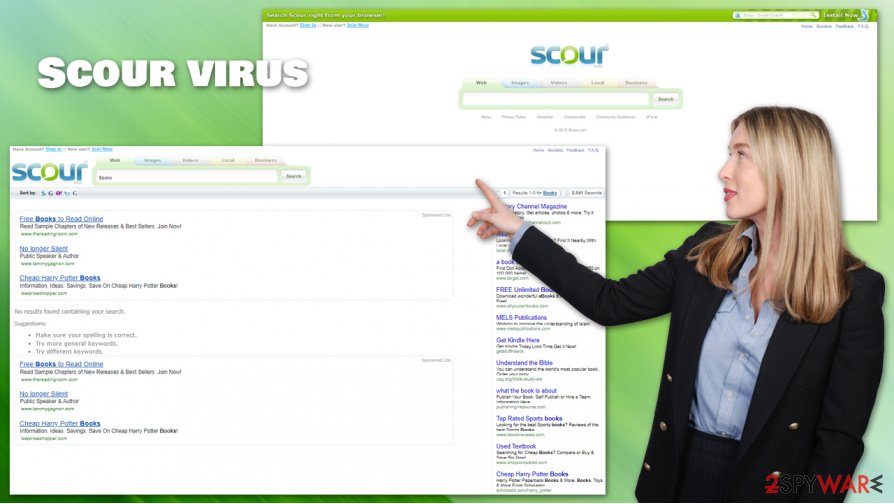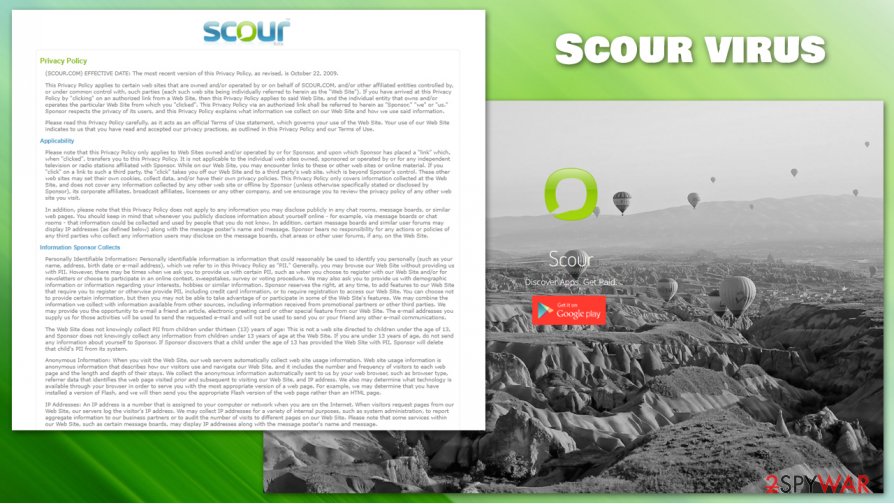Scour virus (Removal Guide) - updated Sep 2020
Scour virus Removal Guide
What is Scour virus?
Scour is a fake search engine that will redirect you to questionable sites

Scour.com (can also be found as Scour or Scour Virus) is a potentially unwanted program, which has been accused of annoying redirects, slowdowns, and similar suspicious activities. No matter that it may look like this domain is prepared for searching the web and looking for the required information, you should use it with extreme carefulness. In fact, it would be better that you would try to avoid Scour because it may show you altered search results that may redirect you to really questionable, suspicious, and unsafe websites.
| Name | Scour virus |
| Type | Browser hijacker, potentially unwanted program |
| Distribution | Software bundle packages, suspicious links, deceptive advertisements, fake updates |
| Symptoms | Homepage and new tab address set to Scour.com; search results are injected with sponsored links; all visited websites show intrusive ads; unknown extension installed on the web browser |
| Dangers | Installation of other PUPs or malware, personal data disclosure to unknown parties, financial loss |
| Removal | Eliminate PUPs automatically by scanning your machine with SpyHunter 5Combo Cleaner or Malwarebytes anti-malware. Alternatively, you can uninstall unwanted apps manually – we provide the instructions below |
| System optimize | In case your machine works slowly or suffers from crashes and errors, you can try to fix these issues with a repair tool FortectIntego |
Scour virus may start tracking your browsing on the web and may collect information related to your browsing routine. Please, do not agree with that because you can never know what is collected by such suspicious search engines and which third parties can use it. Though it hasn't been found that this website spreads malware or infects computer users in any other way, it can completely hijack Google Chrome or another popular web browser without permission.
Scour hijacker authors developed the app in order to insert intrusive ads into searchers and monetize users' clicks. Unfortunately, users have to deal with troubles when trying to find relevant information or even clicking on links they wanted to, as loading ads might alter the placement of website contents. This trait makes the Scour virus exceptionally dangerous, as redirects might lead to malware-laden and other dangerous websites.
If Scour.com hijacker has appeared on your web browser without your approval and now is bothering you with its redirects to questionable websites, slowdowns, pop-up ads, and similar annoying activities, you should waste no time and check your computer with the reputable anti-malware, such as SpyHunter 5Combo Cleaner or Malwarebytes. For manual Scour removal, you can check the instructions we provide below.

You should remember that browser hijackers change the settings of the web browsers and inject cookies for tracking purposes. Thus, it would be the best to reset all the installed browsers to completely remove Scour hijack. All the damage that has been caused to your computer from different types of viruses can be easily removed with FortectIntego.
The unwanted app was most likely installed with freeware
From first sight, Scour.com seems just like another little search engine, which provides the ability to promote yourself through different kinds of ads. However, most PC users who have been using this site for a while claim that its search results should never be trusted. In addition, you should be careful because it may start tracking your browsing habits and may initiate lots of other suspicious activities.
If you have already noticed that each of your web browsers is redirecting you Scour.com, you should think about what freeware have you recently installed on your computer. If that's some kind of download manager, PDF creator, video streaming software, or similar program, it might be that it was involved in the distribution of this suspicious search engine. In this case, you should waste no time and get rid of this program.
The easiest way is to run a full system scan with reputable anti-spyware. Besides, here we should also give you some tips on how can you avoid the Scour virus. The most important thing here is to monitor the installation of the freeware. This can be done by selecting Custom or Advanced installation of the freeware and then carefully following every installation step. Otherwise, this hijacker may take over your start page, default search engine, new tab page, and other system settings.

Remove Scour virus easily
In order to remove Scour from your system, you need to find all its components. Having that in mind, it can either be an extension clipped to Google Chrome, Mozilla Firefox, Safari, or MS Edge browser, or an application that is installed on your system. Since the app can be named as anything, finding it might sometimes be difficult. Nonetheless, we provided detailed manual instructions for that process below.
However, if you want a quick solution for Scour removal, you should employ a powerful anti-malware solution that would be able to detect potentially unwanted programs easily. This way, you will not have to worry that the browser hijacker comes back.
Note that, if the Scour hijack is related to an extension, you can eliminate the unwanted app by simply resetting your web browser or deleting the add-on via the settings menu.
You may remove virus damage with a help of FortectIntego. SpyHunter 5Combo Cleaner and Malwarebytes are recommended to detect potentially unwanted programs and viruses with all their files and registry entries that are related to them.
Getting rid of Scour virus. Follow these steps
Uninstall from Windows
Delete unwanted programs from Windows systems:
Instructions for Windows 10/8 machines:
- Enter Control Panel into Windows search box and hit Enter or click on the search result.
- Under Programs, select Uninstall a program.

- From the list, find the entry of the suspicious program.
- Right-click on the application and select Uninstall.
- If User Account Control shows up, click Yes.
- Wait till uninstallation process is complete and click OK.

If you are Windows 7/XP user, proceed with the following instructions:
- Click on Windows Start > Control Panel located on the right pane (if you are Windows XP user, click on Add/Remove Programs).
- In Control Panel, select Programs > Uninstall a program.

- Pick the unwanted application by clicking on it once.
- At the top, click Uninstall/Change.
- In the confirmation prompt, pick Yes.
- Click OK once the removal process is finished.
Delete from macOS
Remove items from Applications folder:
- From the menu bar, select Go > Applications.
- In the Applications folder, look for all related entries.
- Click on the app and drag it to Trash (or right-click and pick Move to Trash)

To fully remove an unwanted app, you need to access Application Support, LaunchAgents, and LaunchDaemons folders and delete relevant files:
- Select Go > Go to Folder.
- Enter /Library/Application Support and click Go or press Enter.
- In the Application Support folder, look for any dubious entries and then delete them.
- Now enter /Library/LaunchAgents and /Library/LaunchDaemons folders the same way and terminate all the related .plist files.

Remove from Microsoft Edge
Delete unwanted extensions from MS Edge:
- Select Menu (three horizontal dots at the top-right of the browser window) and pick Extensions.
- From the list, pick the extension and click on the Gear icon.
- Click on Uninstall at the bottom.

Clear cookies and other browser data:
- Click on the Menu (three horizontal dots at the top-right of the browser window) and select Privacy & security.
- Under Clear browsing data, pick Choose what to clear.
- Select everything (apart from passwords, although you might want to include Media licenses as well, if applicable) and click on Clear.

Restore new tab and homepage settings:
- Click the menu icon and choose Settings.
- Then find On startup section.
- Click Disable if you found any suspicious domain.
Reset MS Edge if the above steps did not work:
- Press on Ctrl + Shift + Esc to open Task Manager.
- Click on More details arrow at the bottom of the window.
- Select Details tab.
- Now scroll down and locate every entry with Microsoft Edge name in it. Right-click on each of them and select End Task to stop MS Edge from running.

If this solution failed to help you, you need to use an advanced Edge reset method. Note that you need to backup your data before proceeding.
- Find the following folder on your computer: C:\\Users\\%username%\\AppData\\Local\\Packages\\Microsoft.MicrosoftEdge_8wekyb3d8bbwe.
- Press Ctrl + A on your keyboard to select all folders.
- Right-click on them and pick Delete

- Now right-click on the Start button and pick Windows PowerShell (Admin).
- When the new window opens, copy and paste the following command, and then press Enter:
Get-AppXPackage -AllUsers -Name Microsoft.MicrosoftEdge | Foreach {Add-AppxPackage -DisableDevelopmentMode -Register “$($_.InstallLocation)\\AppXManifest.xml” -Verbose

Instructions for Chromium-based Edge
Delete extensions from MS Edge (Chromium):
- Open Edge and click select Settings > Extensions.
- Delete unwanted extensions by clicking Remove.

Clear cache and site data:
- Click on Menu and go to Settings.
- Select Privacy, search and services.
- Under Clear browsing data, pick Choose what to clear.
- Under Time range, pick All time.
- Select Clear now.

Reset Chromium-based MS Edge:
- Click on Menu and select Settings.
- On the left side, pick Reset settings.
- Select Restore settings to their default values.
- Confirm with Reset.

Remove from Mozilla Firefox (FF)
Reset Mozilla Firefox to delete all the unwanted browser hijacker components:
Remove dangerous extensions:
- Open Mozilla Firefox browser and click on the Menu (three horizontal lines at the top-right of the window).
- Select Add-ons.
- In here, select unwanted plugin and click Remove.

Reset the homepage:
- Click three horizontal lines at the top right corner to open the menu.
- Choose Options.
- Under Home options, enter your preferred site that will open every time you newly open the Mozilla Firefox.
Clear cookies and site data:
- Click Menu and pick Settings.
- Go to Privacy & Security section.
- Scroll down to locate Cookies and Site Data.
- Click on Clear Data…
- Select Cookies and Site Data, as well as Cached Web Content and press Clear.

Reset Mozilla Firefox
If clearing the browser as explained above did not help, reset Mozilla Firefox:
- Open Mozilla Firefox browser and click the Menu.
- Go to Help and then choose Troubleshooting Information.

- Under Give Firefox a tune up section, click on Refresh Firefox…
- Once the pop-up shows up, confirm the action by pressing on Refresh Firefox.

Remove from Google Chrome
Delete malicious extensions from Google Chrome:
- Open Google Chrome, click on the Menu (three vertical dots at the top-right corner) and select More tools > Extensions.
- In the newly opened window, you will see all the installed extensions. Uninstall all the suspicious plugins that might be related to the unwanted program by clicking Remove.

Clear cache and web data from Chrome:
- Click on Menu and pick Settings.
- Under Privacy and security, select Clear browsing data.
- Select Browsing history, Cookies and other site data, as well as Cached images and files.
- Click Clear data.

Change your homepage:
- Click menu and choose Settings.
- Look for a suspicious site in the On startup section.
- Click on Open a specific or set of pages and click on three dots to find the Remove option.
Reset Google Chrome:
If the previous methods did not help you, reset Google Chrome to eliminate all the unwanted components:
- Click on Menu and select Settings.
- In the Settings, scroll down and click Advanced.
- Scroll down and locate Reset and clean up section.
- Now click Restore settings to their original defaults.
- Confirm with Reset settings.

Delete from Safari
Remove unwanted extensions from Safari:
- Click Safari > Preferences…
- In the new window, pick Extensions.
- Select the unwanted extension and select Uninstall.

Clear cookies and other website data from Safari:
- Click Safari > Clear History…
- From the drop-down menu under Clear, pick all history.
- Confirm with Clear History.

Reset Safari if the above-mentioned steps did not help you:
- Click Safari > Preferences…
- Go to Advanced tab.
- Tick the Show Develop menu in menu bar.
- From the menu bar, click Develop, and then select Empty Caches.

After uninstalling this potentially unwanted program (PUP) and fixing each of your web browsers, we recommend you to scan your PC system with a reputable anti-spyware. This will help you to get rid of Scour registry traces and will also identify related parasites or possible malware infections on your computer. For that you can use our top-rated malware remover: FortectIntego, SpyHunter 5Combo Cleaner or Malwarebytes.
How to prevent from getting browser hijacker
Access your website securely from any location
When you work on the domain, site, blog, or different project that requires constant management, content creation, or coding, you may need to connect to the server and content management service more often. The best solution for creating a tighter network could be a dedicated/fixed IP address.
If you make your IP address static and set to your device, you can connect to the CMS from any location and do not create any additional issues for the server or network manager that needs to monitor connections and activities. VPN software providers like Private Internet Access can help you with such settings and offer the option to control the online reputation and manage projects easily from any part of the world.
Recover files after data-affecting malware attacks
While much of the data can be accidentally deleted due to various reasons, malware is one of the main culprits that can cause loss of pictures, documents, videos, and other important files. More serious malware infections lead to significant data loss when your documents, system files, and images get encrypted. In particular, ransomware is is a type of malware that focuses on such functions, so your files become useless without an ability to access them.
Even though there is little to no possibility to recover after file-locking threats, some applications have features for data recovery in the system. In some cases, Data Recovery Pro can also help to recover at least some portion of your data after data-locking virus infection or general cyber infection.























